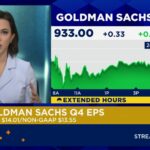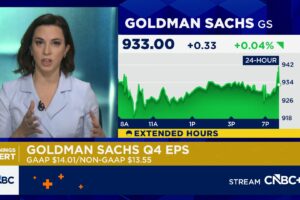You don’t have to buy growth stocks to do well in the stock market.
Since the start of 2023, the Nasdaq Composite has risen a blistering 62%, and the S&P 500 is up 38%. It’s been a great run, but some investors may be worried that the market is poised for a sell-off.
While it’s never a good idea to overhaul your investment strategy based on a speculative hunch, there are safer stocks and exchange-traded funds (ETFs) that can limit downside risk. Here’s why the JPMorgan Equity Premium Income ETF (JEPI 1.00%), the JPMorgan Nasdaq Equity Premium Income ETF (JEPQ 0.20%), and Walmart (WMT 1.34%) are great buys now.

Image source: Getty Images.
Two actively managed funds with clear objectives
The JPMorgan Equity Premium Income ETF is an actively managed fund that invests in the S&P 500 and generates income through equity-linked notes (ELNs) and covered calls. The JPMorgan Nasdaq Equity Premium Income ETF does the same thing but uses the Nasdaq-100 as its benchmark instead of the S&P 500. The Nasdaq-100 is the 100 largest non-financial companies in the Nasdaq Composite.
ELNs combine bonds and equity options to generate income and benefit from the potential upside of equity prices. They are basically alternatives to low-yield and fixed-income products with higher potential upside, but also the possibility of a lower return if the options expire worthless.
Covered calls can be sold on equity to generate income. In exchange for collecting a premium, the seller of the call caps their upside potential.
Let’s use Microsoft (NASDAQ: MSFT) as an example. The price of Microsoft stock is around $430 per share. Let’s say you want to sell an August 2024 $450 covered call. At the time of this writing, that option goes for about $10.70. The buyer pays you $10.70 per share upfront in exchange for the option to buy the stock at $450 anytime between now and the expiration, which is Aug. 16, 2024. The premium of $10.70 divided by the share price of $430 is basically a guaranteed 2.5% yield in a few months.
The covered call will generate a higher return than holding the stock unless Microsoft is above the strike price ($450) plus the call premium ($10.70) — so $460.70. At that point, it would have been better to simply own the stock rather than the stock plus the covered call.
A covered call strategy will do better than holding the stock if the stock price goes up slightly, stays the same, or goes down. A great example is 2022. The S&P 500 produced a total return of negative 18.1%, but the JPMorgan Equity Premium Income ETF produced a total return of only negative 3.5% because call premiums and income from ELNs helped offset equity losses.
However, since the start of 2023, simply investing in the S&P 500 or Nasdaq-100 without covered calls would have been a better strategy.
Recently, mega cap growth has led the broader indices to new heights. If a fund sold covered calls on red-hot stocks like Nvidia or Meta Platforms, it would have missed out on monster gains.
Still, these two JPMorgan ETFs could be a good choice for investors who want to keep putting capital to work in the market but also want guaranteed passive income and some downside risk protection.
The yields vary based on which contracts the actively managed fund enters. But the trailing yield of the Equity Premium Income ETF is 7.6%, and the Nasdaq Equity Premium Income ETF’s trailing yield is 9.3%. Call premiums tend to be higher on growth stocks because of the upside potential, which is why the growth-focused Nasdaq product has a higher yield than the S&P 500 product.
Another added benefit is that income is distributed monthly, unlike a quarterly dividend — making both ETFs frequent and sizable passive income sources. Both funds have expense ratios of just 0.35%, which is a great price for an actively managed and rather complex product.
A Dividend King with room to run
If the ETF route isn’t your style, or you prefer not to cap your upside, then investing in rock-solid dividend stocks is another worthwhile option to consider. Walmart is a Dividend King that has raised its payout for 51 consecutive years. It yields just 1.3%, but there’s reason to believe Walmart could be doing more sizable dividend raises in the future.
In fiscal 2025, Walmart expects to grow adjusted earnings per share (EPS) by at least 4% and net sales by at least 6%. Despite the pandemic and supply chain challenges, Walmart grew sales by 26.9% over the last five years and diluted EPS by 57.9%.
Walmart has made some sizable investments in recent years. Its trailing 12-month capital expenditures now exceed $20 billion, nearly double the pre-pandemic levels.
WMT Capital Expenditures (TTM) data by YCharts
Walmart has expanded its product mix to better align with consumer preferences and create value for its customers. It has executed widespread store remodels and is building new stores under its Store of the Future concept. In January, Walmart said it plans to remodel 650 stores over the next 12 months. In its recent fiscal 2025 first-quarter earnings call, the company said it is now on track to complete 900 remodels this year.
Walmart has invested in curbside pickup, Walmart+, and Walmart + InHome. These out-of-store options are Walmart’s way of providing convenience to customers and increasing its e-commerce offering to better compete with other retailers (particularly Amazon).
These investments have come at a high cost, but the long-term benefits have yet to be reflected in Walmart’s profits — suggesting earnings growth and dividend raises could accelerate from here. And with a mere 33% payout ratio, Walmart has plenty of room to raise its dividend.
Get creative with ETFs and dividend stocks
Regularly contributing new savings to your stock portfolio and investing no matter what the market is doing is a great way to compound wealth over time. These two covered call-focused funds generate more passive income than many high-yield dividend stocks, and could outperform the broader benchmarks if the market cools off.
However, long-term investors may prefer an industry-leading Dividend King like Walmart. Although it has a lower yield, the company has a clear path to compounding earnings over time.
Perhaps the best approach is a combination of ETFs and dividend stocks to boost passive income and achieve diversification. Today’s age of low-cost funds and little to no trading fees through most brokerage accounts allows investors to get creative and build a portfolio that suits their risk tolerance and interests, and helps them achieve their financial goals.
John Mackey, former CEO of Whole Foods Market, an Amazon subsidiary, is a member of The Motley Fool’s board of directors. Randi Zuckerberg, a former director of market development and spokeswoman for Facebook and sister to Meta Platforms CEO Mark Zuckerberg, is a member of The Motley Fool’s board of directors. Daniel Foelber has no position in any of the stocks mentioned. The Motley Fool has positions in and recommends Amazon, Meta Platforms, Microsoft, Nvidia, and Walmart. The Motley Fool recommends the following options: long January 2026 $395 calls on Microsoft and short January 2026 $405 calls on Microsoft. The Motley Fool has a disclosure policy.













